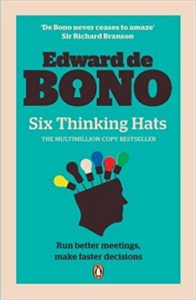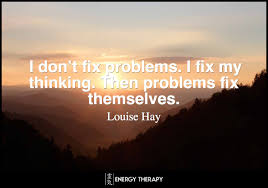- White Hat: Concerned with objective facts and figures. Role play being a computer, just give objective facts without your own biases.
- Red Hat: Gives the emotional view. An opportunity to express feelings or intuition without needing to justify them.
- Black Hat: Points out the weakness in an idea. Critical thinking to caution and prevent us from wasting money and energy.
- Yellow Hat: Optimistic, covers hope and positive thinking. Forces people to spend time seeking out value. Constructive and logically lays out what is right with an idea.
- Green Hat: Indicates creativity and new ideas. The energy hat, full of possibilities, finds new approaches to problems, even crazy ones (later put in an idea box).
- Blue Hat: The organization of thinking process and use of other hats. Asking the right questions, defining the problem, setting the thinking tasks. The chairperson.
The meeting chairperson can say,
“Let’s switch to yellow hat and see how big can this initiative be. Please think two minutes on your own and then each participant will speak for exactly one minute on yellow hat only.”
Or, “I am not yet satisfied with the alternatives we have so far. Let’s put ur Green Hat and we will go around the room.”
Or towards the end of a meeting, “Are we happy with the outcome, did we do a good job? Let’s everyone wear the Red Hat and describe their feelings in maximum 5 words”.
We also need to be cautious against the overuse of a hat. For example, black hat thinking is important but overuse can make people get comfortable in criticizing instead of contributing. An idea which is 80% good and 20% imperfect can be criticized (and all focus going on the 20%) in the design phase because we can still correct the 20%. But in the final assessment phase, the excellent 80% should be acknowledged.
In companies as varied as ABB, NASA, Shell, IBM, Dupont, NTT, this has resulted in 75% reduction in meeting time (less wasteful to and fro) and 5 times increase in productive ideas (the intelligence, knowledge and experience of each team member is put to full use). It also leaves much lesser ego bruises and fosters better cooperation.
I have often used this in my meetings and can vouch for the results. With 20 people in a project, there is always a fear that someone’s views are not heard or someone’s views get dominating. Or we may have missed a risk or missed an opportunity. So, we can ask everyone, “let’s have a round of red Hat”, where everyone just describes their feelings (without any justification). Or just before agreeing on a project, ask everyone to give one Black Hat idea (what could go wrong).
Depending on the situation, you could do only one hat, or few or all hats or repeat hats. The important criteria are Discipline (when one hat is being discussed, even opponents need to think in the same direction); Time management (put idea succinctly and move on, generally one minute per participant per hat); and Process (when will which hat be used).
The book has few chapters on how to use each hat and the challenges therein, but often gets repetitive. I do think this could have been a great HBR kind of article instead of a full volume book.





 This information will never be shared with third party
This information will never be shared with third party
Excellent. made my job very easy . I needed to make a think tank but now i am clear what to do